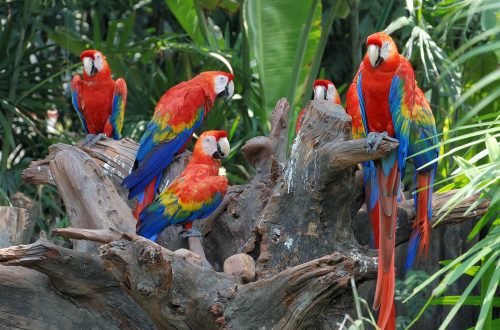
What do parrots eat
The diet of parrots in the wild is so diverse that it is sometimes quite difficult to create a similar menu at home. The reason lies in the habitat of these beautiful and unusual birds. Such territories are not famous for cold winters or other dramatic climatic changes. Droughts and rainy seasons are what separates the seasons in latitudes, where do parrots live.
Free access to tropical fruits, berries, flowers and trees directly affects the bird’s health and appearance. In search of food, parrots travel long distances, taking into account the seasons. They adapt to the seasonal ripening of certain fruits and plants, which is also an important point in nutrition.

When there are many fruits and seeds rich in vitamins, the breeding season begins, which coincides with the rainy season.
Due to the destruction of the habitat of birds, their extermination by local residents (birds often cause damage to farmers’ fields or their bright feathers serve as decoration in rituals), capture of birds by poachers – some species of parrots are on the verge of extinction.
Also, having lost their usual diet, not all of them adapt to the changed conditions. Not having received the right amount of useful and nutritious substances, even if offspring arise, it can be weakened and more prone to disease. The survival rate of chicks is decreasing, which cannot but affect the number of birds in the flock.

Therefore, the issue of a balanced diet for parrots is extremely important in nature.
What do parrots eat in the wild?
Large species of parrots in the wild prefer to eat fruits, seeds of a wide variety of fruit trees. These fruits can be of varying degrees of maturity. Nuts (palm and Brazil nuts) also occupy a significant part of the diet of birds, as do berries, flowers, young shoots of plants, insect larvae and even snails.

Many parrots, even within their own species, differ in their preferred food. Again, this has to do with habitat.
If the view Ara considered herbivorous, the hyacinth macaw can be classified as a granivorous species. This parrot feeds mainly on palm nuts.
Gray African parrot has quite interesting eating habits in the wild. The main product on his menu is the fruits of the red oil palm.
Jaco can get vital vitamins only from the fruits of the oil palm tree, therefore they are recommended to be used in the diet of a domestic parrot.
Also, African parrots love to feast on the fruits of papaya (melon tree), berries, nuts and flowers.
Medium parrot species are very fond of fruits, seeds, plants and insects. Long-billed emerald parrot deftly digs up roots, plant bulbs and tubers. BUT Lori (nectarivorous species), primarily feed on nectar, flowers, ripe fruit pulp and juice.

Small parrot species such as budgerigars and lovers most often, all kinds of plant seeds, young shoots, berries and fruits are chosen for the main food.
Because the parrots eat a large number of different grains, they are considered granivorous birds. In the wild, their diet is very varied and well balanced. At home, in addition to grain feed, the menu for birds must contain fruits, vegetables and herbs.
Don’t forget that even grain-eating parrots shouldn’t eat seeds alone.

In nature, birds eat grains of very different degrees of maturity, they especially love young dairy seeds of plants. Therefore, one dry food, at home, is detrimental to the health of the bird! What can you give a parrot besides food you will read in this article.
In captivity, it is very difficult to bring the bird’s nutrition closer to that which it receives in the wild. Yes, this is not always possible. The food of wild parrots is very nutritious and is most often fatty and high-calorie food. But birds, while searching for food, spend an enormous amount of energy, their flights stretch for more than a dozen kilometers, so obesity and imbalance do not threaten handsome men.
In captivity, the parrot does not expend so much energy, its flights are short-lived, and some birds, unfortunately, are not given the opportunity to fly at all in accordance with its needs.
Of course, this does not mean at all that you need to transfer it completely to diet food.

It is important to observe the ratio of grain feed and fruit and berry, fruit and vegetable supplements in diet.
Some types of parrots need nuts, but the frequency of intake must be strictly regulated by the owner.
You also need to be careful about what kind of grain your parrot prefers, as they will often choose the most delicious grains for their taste, and the rest will be scattered. In this case, the bird receives less nutrients, which is fraught with poor health.
In the wild, parrots self-regulate their diet. But it also depends on the yield and human intervention in the habitat of birds. At home, the responsibility for the health of a feathered pet lies with its owner. Properly balanced menu taking into account the geographical homeland of the parrot and home conditions, it will be the key to its health and longevity.





